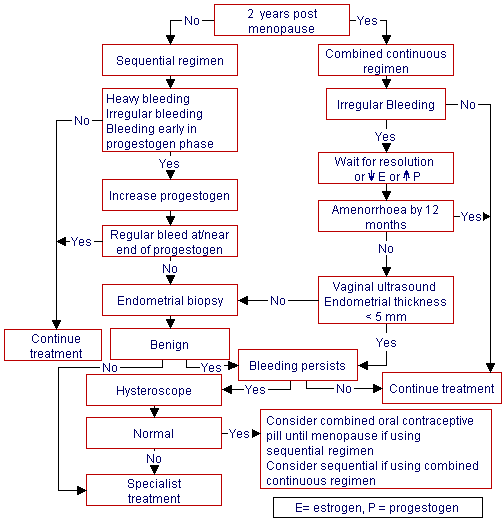|
continuous sequential evaluating it When a woman goes on the continuous combined type of HRT where the pill/patch is the same every day the doctor may well say that she "shouldn't" bleed after three months. This really means that "'with any luck" she won't - not that if she does, something's wrong - but scared women have reported on the internet that not only they but their doctors have feared cancer when faced by continued spotting/bleeding beyond this point. It is easy to show that this
worry is probably unfounded if one looks at the full prescribing information
for brands of continuous combined HRT. This includes results of studies
on a specific drug which evaluated bleeding profiles over 12 months.
The percentages of women achieving cumulative amenorrhea, (which is the
state of being bleedfree at a certain point and maintaining this freedom
until the end of the study at 12 months) were very far from 100% at 3 months
- or even later.
Note 1:There are 2 "Prempro" and "Combipatch" numbers because there are two progestin doses available - the higher progestin variety is more succcessful against bleeding but also produces more unpleasant side effects. Note 2: Activella reports bleeding patterns differently - i.e numbers of women not bleeding in a specific month (which doesn't necessarily mean that they won't bleed again later) so its numbers are not directly comparable to the ones above. The numbers are : month 1 - 88%, month 3 - 84%, month 6 - 93%, month 12 - 97%. Note that *more* women were bleeding at month 3 than at month 1. Bleeding on continuous combined
formulations can happen at any time. This inconvenient unscheduled
bleeding is more likely to occur in women who are not long past menopause
and because of this many doctors tell women that they should use sequential
preparations until they are two years postmenopausal. This way, they can
be fairly sure of knowing when a regular "period" will occur and can prepare
accordingly. Even well after menopause, a woman who continues to bleed
anyway will probably prefer the scheduled variety which has the added advantage
of having been used since the 1970's so there is some knowledge of its
long term effects.
An article at http://www.xtn.net/com/uppgobg/nbleed.htm#pmbhrt reports on further study using a different type of estrogen, and for an even longer time In a recent article, Nand et al: Bleeding pattern and endometrial changes during continuous combined hormone replacement therapy. Obstet Gynecol 1998;91:678-84, investigated estrone 1.25 mg (Ogen®) with 3 different doses of medroxyprogesterone acetate (Provera®) 2.5 mg, 5.0 mg and 10mg. They recorded how much bleeding 568 women had over 2 years on the different regimens. Sequential HRT entails taking estrogen for all or most of the month, with a progestogen added for a varying number of days (hopefully not fewer than 10 for safety's sake). Once the progestogen is stopped a "period' (more accurately, a withdrawal bleed) can be expected within a few days. So long as this happens, then it is reasonable to assume that all is well with the uterus, but sometimes it doesn't and then there *may* be cause for further investigation. There are various medical guidelines available on the internet which lay out standard procedure for "their" doctors to follow when evaluating bleeding on HRT (continuous or sequential). A very recent one (May 2001) is contained in New Zealand's Best Practice Evidence-based Guideline for the APPROPRIATE PRESCRIBING of HORMONE REPLACEMENT THERAPY To get this entire guideline, it's necessary to download a book length .pdf file, so I have extracted the flowchart summarising the recommendations for NZ doctors to follow. These recommendations are all based on evidence from good quality studies (references are provided in the document) and are up to date.
For a comprehensive article on all aspects of bleeding while on HRT see http://www.womenandmenopause.com/OpinionPapers-Interpreting_HRT_Bleeding_Data.htm Also see postmenopausal bleeding. |
